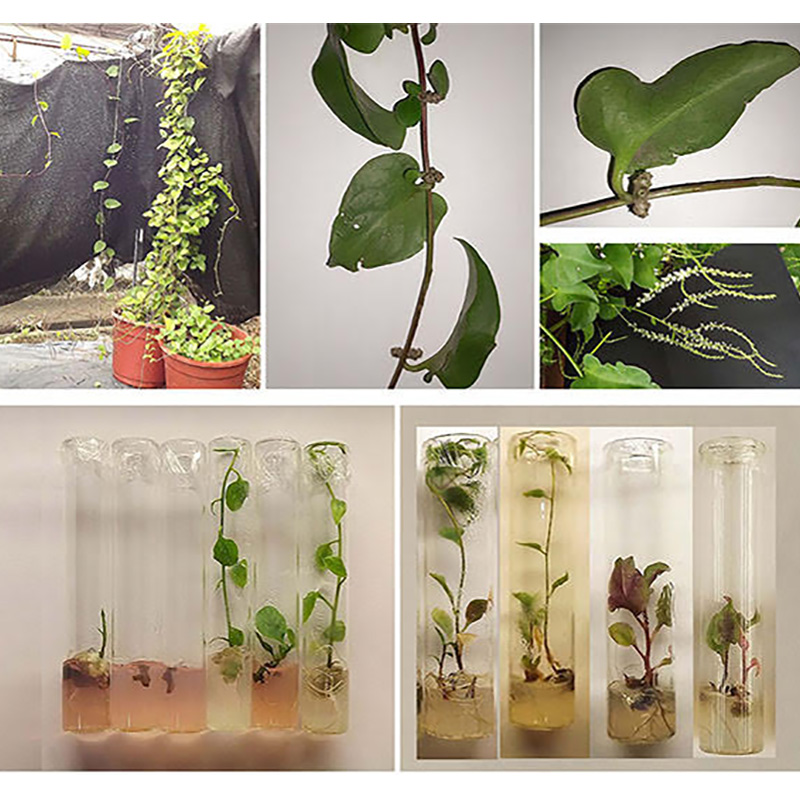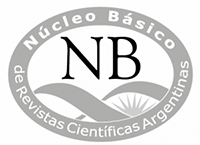Micropropagation of Anredera cordifolia (Basellaceae)
DOI:
https://doi.org/10.31055/1851.2372.v59.n4.44826Keywords:
Biotecnología., Anredera cordifolia, Aclimatización, Cultivo de tejidos, Propagación in vitroAbstract
Background and aims: The potato vine (Anredera cordifolia) is a climbing plant of the Basellaceae family, with extensive potential for both food and medicinal purposes. The aim of this work was to develop an efficient micropropagation protocol for this species.
M&M: Different factors that affect the different stages of the process were evaluated, including adjustments in the disinfection of plant material for aseptic culture establishment, in vitro multiplication, and greenhouse acclimatization of the regenerated plants.
Results: For aseptic establishment, the most effective treatment in avoiding contamination, allowing explant survival, and promoting plant regeneration was the use of 1.7% active Cl. In the in vitro multiplication stage, the influence of the Murashige and Skoog (MS) basal medium and its dilutions were tested. It was demonstrated that the original concentration of MS was the most suitable for plant regeneration and promoted the highest rates of in vitro multiplication. In vitro plants derived from different dilutions of the MS basal medium were transferred to ex vitro growth conditions. Plants regenerated in MS reduced to a quarter exhibited the highest survival rate compared to the other treatments.
Conclusion: This study constitutes the first attempt to the micropropagation of A. cordifolia. This contribution is crucial for the establishment of an efficient large-scale propagation system as well as for germplasm preservation of this species.
References
ABUBACKER, M. N., G. GANAPATHY, L. M. SEBASTIN & K. S MONDAL. 2019. Histochemical and shoot induction studies of Basella rubra L. (Basellaceae). Biosci. Biotechnol. Res. Asia 16: 187-194. http://dx.doi.org/10.13005/bbra/2736
ALBA, T. M., C. M. GARLET DE PELEGRIN & A. M. SOBOTTKA AM. 2020. Pharmacognosy Ethnobotany, ecology, pharmacology, and chemistry of Anredera cordifolia (Basellaceae): a review. Rodriguésia 70: 1-11. http://dx.doi.org/10.1590/2175-7860202071060
ARIZAGA, M. V., S. I. YAMAMOTO, D. TANAKA, K. FUKUI, ... & T. NIINO. 2017. Cryopreservation of in vitro shoot tips of ulluco (Ullucus tuberosus Cal.) using D cryo-plate method. CryoLetters 38: 419-427.
AYELE, Y. Z. & W. TEFERA. 2018. Low cost sterilization technique and in vitro initiation of vanilla (Vanilla planifolia Andr.). J. Agric. Food Res. 9: 1-6.
BENOMARI, F. Z., M. SARAZIN, D. CHAIB, A. PICHETTE, … & N. DJABOU. 2023. Chemical variability and chemotype concept of essential oils from Algerian wild plants. Molecules 28: 4439. https://doi.org/10.3390/molecules28114439
CUBA-DÍAZ, M., C. RIVERA-MORA, E. NAVARRETE E & M. KLAGGES. 2020. Advances of native and non-native Antarctic species to in vitro conservation: improvement of disinfection protocols. Sci. Rep. 10: 3845. https://doi.org/10.1038/s41598-020-60533-1
DI RIENZO, J. A., CASANOVES, F., BALZARINI, M. G., GONZÁLEZ L., … & ROBLEDO, C. W. 2017. InfoStat versión 2017. Grupo InfoStat, FCA, Universidad Nacional de Córdoba, Argentina. Disponible en: http://www.infostat.com.ar.
DIAB, E. E. & S. E. MOHAMED. 2008. In vitro morphogenesis and plant regeneration of bamboos (Oxytenanthera). Int. J. Sustain. Crop Prod. 3: 72-79.
DJAMIL, R., P. R. WAHYUDI, S. WAHONO & M. HANAFI. 2012. Antioxidant activity of flavonoid from Anredera cordifolia (Ten) Steenis leaves. Int. Res. J. Pharm. 3: 241-243.
GAMMOUDI, N., K. NAGAZ & A. FERCHICHI. 2022. Establishment of optimized in vitro disinfection protocol of Pistacia vera L. explants mediated a computational approach: multilayer perceptron–multi− objective genetic algorithm. BMC Plant Biol. 22: 1-13.
GARMANA, A. N., E. Y. SUKANDAR & I. FIDRIANNY. 2016. Preliminary study of blood pressure lowering effect of Anredera cordifolia (Ten) Steenis on Wistar rats. Int. J. Pharmacogn. Pharm. Res. 8: 300-304.
GOICOCHEA, R. C. C., M. C. MARTÍNEZ LAURENTE & J. T. R. CHUMBES. 2020. Propiedades funcionales de productos tradicionales congelados y secados al sol de oca (Oxalis tuberosa Molina) y olluco (Ullucus tuberosus Caldas): Una revisión. Puriq 2: 363-387. https://doi.org/10.37073/puriq.2.3.100
HAMMOND HAMMOND, S. D., I. VIEHMANNOVA, J. ZAMECNIK & P. H. CEPKOVA. 2019. Efficient slow-growth conservation and assessment of clonal fidelity of Ullucus tuberosus Caldas microshoots. Plant Cell Tiss. Organ Cult. 138: 559-570. https://doi.org/10.1007/s11240-019-01653-z
HASANAH, Y. & L. MAWARNI. 2020. Exploration and identification of Anredera cordifolia morphological characters in the highlands and lowlands. Biodiversitas 21: 2759-2766. https://doi.org/10.13057/biodiv/d210652
HEYDARI, H. R. & E. CHAMANI. 2022. High-frequency plant regeneration and genetic fidelity assessment of regenerants by molecular and biochemical markers in Woodland Sage (Salvia nemorosa L.). Ind Crop Prod 187: 115404. https://doi.org/10.1016/j.indcrop.2022.115404
IANNICELLI, J., M. C. P. DE LA TORRE, M. A. COVIELLA, E. D. V. AGUIRRE, … & A. S. ESCANDÓN. 2016. In vitro propagation of Lippia integrifolia (Griseb.) Hier. and detection of genetic instability through ISSR markers of in vitro-cultured plants. Rev. Fac. Nac. Agron. 115: 67-76.
JORDAN, M., A. AMENÁBAR & C. ROVERARO. 2002. Rapid in vitro propagation and microtuber production in Ullucus tuberosus (Basellaceae). Gartenbauwissenschaft 67: 50-54.
JUNAIRIAH, F., N. TRI & N. I. ZURAIDASSANAAZ. 2023. Callus induction of Anredera cordifolia L. with various concentration of benzyl amino purin (BAP). Eur. Chem. Bull. 12: 2396-2400. doi:10.31838/ecb/2023.12.1.319
KINUPP, V. F., F. S. AMARO & I. B. I. BARROS. 2004. Anredera cordifolia (Basellaceae), uma hortaliça potencial em desuso no Brasil. Hortic. Bras. 22: 1-6.
KOVALCHUK, I. Y., Z. MUKHITDINOVA, T. TURDIYEV, G. MADIYEVA, … & B. M REED. 2018. Nitrogen ions and nitrogen ion proportions impact the growth of apricot (Prunus armeniaca) shoot cultures. Plant Cell Tiss. Org Cult. 133: 263-273. https://doi.org/10.1007/s11240-018-1379-8
KUMAR, S.S. & P. GIRIDHAR. 2021. In vitro micropropagation of Basella rubra L. through proliferation of axillary shoots. Plant Cell Tiss. Organ Cult. 144: 477-483. https://doi.org/10.1007/s11240-020-01960-w
KUSUMANTI, E. & S. SUGIHARTO. 2017. Effect of dietary supplementation of binahong leaf meal, betel nut meal or their combination on serum albumin and globulin, fecal endoparasites and bacterial counts in milk of Saanen goats suffering from subclinical mastitis. Agric. Nat. Resour. 51: 415-419.
LAZO-JAVALERA, M. F., R. TRONCOSO-ROJAS, M. E. TIZNADO-HERNÁNDEZ, M. A. MARTÍNEZ TELLEZ, … & M. RIVERA-DOMÍNGUEZ. 2016. Surface disinfection procedure and in vitro regeneration of grapevine (Vitis vinifera L.) axillary buds. Springerplus 5: 1-9. https://doi.org/10.1186/s40064-016-2081-0
LELIQIA, N. P. E., E. Y. SUKANDAR & I. FIDRIANNY. 2017. Overview of efficacy, safety and phytochemical study of Anredera cordifolia (Ten.) Steenis. Pharmacologyonline 1: 124-131.
MANZELLI, M., L. ANDRENELLI, S. BENEDETTELLI & V. VECCHIO. 2004. Effect of temperature and sucrose on ulluco (Ullucus tuberosus Caldas) microtuber production under neutral photoperiodic conditions. Adv. Hortic. Sci. 18:1-4.
MARTINS, J. P. R., M. PASQUAL, A. D. MARTINS & S. F. RIBEIRA. 2015. Effects of salts and sucrose concentrations on in vitro propagation of Billbergia zebrina (Herbert) Lindley (Bromeliaceae). Aust. J. Crop Sci. 9: 85-91.
MEDINA, R. D., S. C. SCHALLER, N. R. DOLCE & L. A. MROGINSKI. 2017. Determinación de la eficiencia de la micropropagación de genotipos de mandioca (Manihot esculenta, Euphorbiaceae) de interés para el Nordeste Argentino. Bol. Soc. Argent. Bot. 52: 497-505. https://doi.org/10.31055/1851.2372.v52.n3.18029
MROGINSKI, L. A., P. A. SANSBERRO, H. Y. REY & M. M. COLLAVINO. 1997. Micropropagación de la yerba mate (Ilex paraguariensis St. Hil.): Estado Actual y perspectivas. En: Anais I Congresso Sul-Americano da Erva-Mate, pp. 141-151. Embrapa, Curitiba.
MURASHIGE, T. & F. SKOOG. 1962. A revised medium for rapid growth and bioassay with tobacco tissue cultures. Physiol. Plant. 15: 473-497. https://doi.org/10.1111/j.1399-3054.1962.tb08052.x
NASUTION, N. A., I. M. ARTIKA & D. SAFARI. 2020. Antibacterial activity of leaf extracts of Anredera cordifolia (Ten.) Steenis and Muntingia calabura L. against Streptococcus pneumoniae. Curr. Biol. 7: 1-9. https://doi.org/10.29244/cb.7.1.1
PARZYMIES, M., M. POGORZELEC & A. ŚWISTOWSKA. 2022. Optimization of propagation of the Polish strain of Aldrovanda vesiculosa in tissue culture. Biology 11: 1389. https://doi.org/10.3390/biology11101389
PIÑEROS, A. L. M., L. M. P. OSPINA, J. F. H. MONTAÑO, M. L. I. PIÑEROS & J. R. OSORIO. 2019. Caracterización etnobotánica de las plantas medicinales empleadas en el tratamiento de las enfermedades cardiometabólicas, Villa de Leyva-Boyacá. Rev. Cubana Plant Med. 24: 1-22.
PITOYO, A., RESTYKANIA, SURATMAN & SURANTO. 2019. Morphology and isozyme variation among madeira vine (Anredera cordifolia) accessions from southeastern part of Central Java, Indonesia. Biodiversitas 20: 3024-3032. https://doi.org/10.13057/biodiv/d201035
REED, B. M., J. DENOMA, S. WADA & R. NIEDZ. 2016. Determining optimum in vitro mineral nutrition for diverse pear germplasm using response surface methodology. Acta Hortic. 1113:79-84. https://doi.org/10.17660/ActaHortic.2016.1113.11
ROSALES, C., J. BRENES, K. SALAS, S. ARCE-SOLANO & A. ABDELNOUR-ESQUIVEL. 2018. Micropropagación de Stevia rebaudiana en sistemas de inmersión temporal para incursionar en la producción hortícola. Rev. Chapingo Ser. Hortic. 24: 69-84. https://doi.org/10.5154/r.rchsh.2017.08.028.
SAN GREGORIO, J. P. R., N. M. PIOTO, V. A. FORTI, J. RODRIGUES, P. V. DA SILVA, P. A. MONQUERO. 2021. Propagation and control of Anredera cordifolia (Ten.) Stennis (madeira vine). https://doi.org 10.21475/ajcs.21.15.08.p3320
SHEKHAWAT, M. S. & M. MANOKARI. 2016. Optimization of in vitro and ex vitro regeneration and micromorphological studies in Basella alba L. Physiol Mol Biol Plants. 22: 605-612. https://doi.org/10.1007/s12298-016-0388-5
SOUZA, L. F., I. B. I. DE BARROS, E. MANCINI, L. D. MARTINO, … & V. D. FEO. 2014. Chemical composition and biological activities of the essential oil from Anredera cordifolia grown in Brazil. Nat. Prod. Commun. 9: 1003-1006. https://doi.org/10.1177/1934578X1400900730
SUGIYARTO, L. & P. C. KUSWANDI. 2014. Callus induction of binahong leaves (Anredera cordifolia L.) for the development of traditional medicinal plant. J. Sains Dasar 3: 56-60. https://doi:10.21831/jsd.v3i1.2787
SUKANDAR, E. Y., A. QOWIYYAH & L. LARASATI. 2011. Effect of methanol extract heart leaf madeira vine (Anredera cordifolia (Ten.) Steenis) leaves on blood sugar in diabetes mellitus model mice. J. Med. Plant Res. 1: 1-10.
TEIXEIRA DA SILVA, J. A., E. NEZAMI-ALANAGH, M. E. BARREAL, M. M. KHER, … & J. DOBRÁNSZKI. 2020. Shoot tip necrosis of in vitro plant cultures: a reappraisal of possible causes and solutions. Planta 252:47. https://doi.org/10.1007/s00425-020-03449-4
VIEHMANNOVÁ, I., M. TRÁVNÍČKOVÁ, E. ŠPATENKOVÁ, M. ČERNÁ & P. TRÁVNÍČEK. 2012. Induced polyploidization and its influence on yield, morphological, and qualitative characteristics of microtubers in Ullucus tuberosus. Plant Cell Tiss. Organ Cult. 109: 83-90. https://doi.org/10.1007/s11240-011-0076-7
VIVIAN-SMITH, G., B. E. LAWSON, I. TURNBULL & P. O. DOWNEY. 2007. Review: The biology of Australian weeds 46. Anredera cordifolia (Ten.) Steenis. Plant Prot. Q. 22: 1-10.
WIDYARINI, K. D., E. Y. SUKANDAR, I. R. & D. A. FIDRIANNY. 2015. Xanthine oxidase inhibitory and anti-hyperuricemic activities of Anredera cordifolia (Ten.) Steenis, Sonchus arvensis L., and its combination. Int. J. Pharm. Pharm Sci. 7: 87-90.
XIFREDA, C. C., S. ARGIMÓN & A. F. WULFF. 1999. Infraspecific characterization and chromosome numbers in Anredera cordifolia (Basellaceae). Thaiszia 9: 99-108.
LEYENDA DE FIGURAS Y TABLA
Fig. 1. Micropropagación de enredadera papa (Anredera cordifolia). A: Plantas cultivadas en maceta y a la intemperie en Corrientes, Capital. B: Tallo voluble con hojas simples y cordadas. C: Tubérculo aéreo en la axila de una hoja. D: Rama florífera. E: Respuestas obtenidas in vitro, luego de la desinfección con 1,7 % Cl activo y establecimiento en el medio basal MS luego de 30 d de cultivo. F: Plantas regeneradas in vitro luego de 30 d (de izquierda a derecha: en medio basal MS en su concentración original, diluido al 1/2, 1/4 y 1/8). G-H: Plantas regeneradas in vitro en MS y en MS diluido al 1/4 a los 30 d de cultivo, respectivamente. I-J: Plantas aclimatadas en invernadero a los 60 d y 120 d de su trasplante, respectivamente. Escalas= A, J: 10 cm; B, D: 2 cm; C, E-I: 1 cm.
Fig. 2. Evaluación del efecto de los tratamientos de desinfección en explantes nodales de A. cordifolia cultivados in vitro. Letras distintas indican diferencias significativas en el porcentaje de explantes con vástago y raíces según el Test de Comparaciones Múltiples de Duncan (p≤ 0,05).
Fig. 3. Evaluación del efecto de las diluciones del medio de cultivo y de diferentes accesiones de A. cordifolia sobre la multiplicación in vitro al cabo de 30 d. A: Regeneración in vitro de plantas (%). B: Número de nudos por explante. C: Longitud del vástago de las plantas regeneradas (mm). En B y C, las letras distintas indican diferencias significativas según el Test de Comparaciones Múltiples de Duncan (p≤ 0,05) entre tratamientos. Abreviaturas = CL: accesión proveniente de Colonia Liebig, Corrientes; CT: accesión proveniente de Corrientes, Capital; SF: accesión proveniente de Ingeniero Chanourdié, Santa Fe; CH: accesión proveniente de Resistencia, Chaco; MS: medio basal de Murashige y Skoog (1962) y sus diluciones al 1/2, 1/4 y 1/8.
Fig. 4. Evaluación del efecto de las diluciones del medio de cultivo y de diferentes accesiones de A. cordifolia sobre el porcentaje de plantas aclimatadas al cabo de 60 d de su transferencia a condiciones ex vitro. Letras distintas indican diferencias significativas según el Test de Comparaciones Múltiples de Duncan (p≤0,05). Abreviaturas = CL: accesión proveniente de Colonia Liebig, Corrientes; CT: accesión proveniente de Corrientes, Capital; SF: accesión proveniente de Ingeniero Chanourdié, Santa FeM; CH: accesión proveniente de Resistencia, Chaco; MS: medio basal de Murashige y Skoog (1962) y sus diluciones al 1/2, 1/4 y 1/8.
Tabla 1. Evaluación del efecto de las diluciones del medio de cultivo y de las diferentes accesiones de A. cordifolia sobre el peso fresco y seco (mg) de las plantas regeneradas in vitro. Letras distintas en los efectos simples de la dilución del medio de cultivo y la procedencia de las accesiones, indican diferencias significativas según el Test de Comparaciones Múltiples de Duncan (p≤0,05). Abreviaturas = CL: accesión proveniente de Colonia Liebig, Corrientes; CT: accesión proveniente de Corrientes, Capital; SF: accesión proveniente de Ingeniero Chanourdié, Santa Fe; CH: accesión proveniente de Resistencia, Chaco; MS: medio basal de Murashige y Skoog (1962) y sus diluciones al 1/2, 1/4 y 1/8.

Downloads
Published
Issue
Section
License
Copyright (c) 2024 Silvia C Schaller, Natalia R. Dolce, Luis A. Mroginski, Ricardo D. Medina

This work is licensed under a Creative Commons Attribution-NonCommercial-NoDerivatives 4.0 International License.
Provides immediate and free OPEN ACCESS to its content under the principle of making research freely available to the public, which fosters a greater exchange of global knowledge, allowing authors to maintain their copyright without restrictions.
Material published in Bol. Soc. Argent. Bot. is distributed under a Creative Commons Attribution-NonCommercial-ShareAlike 4.0 International license.










